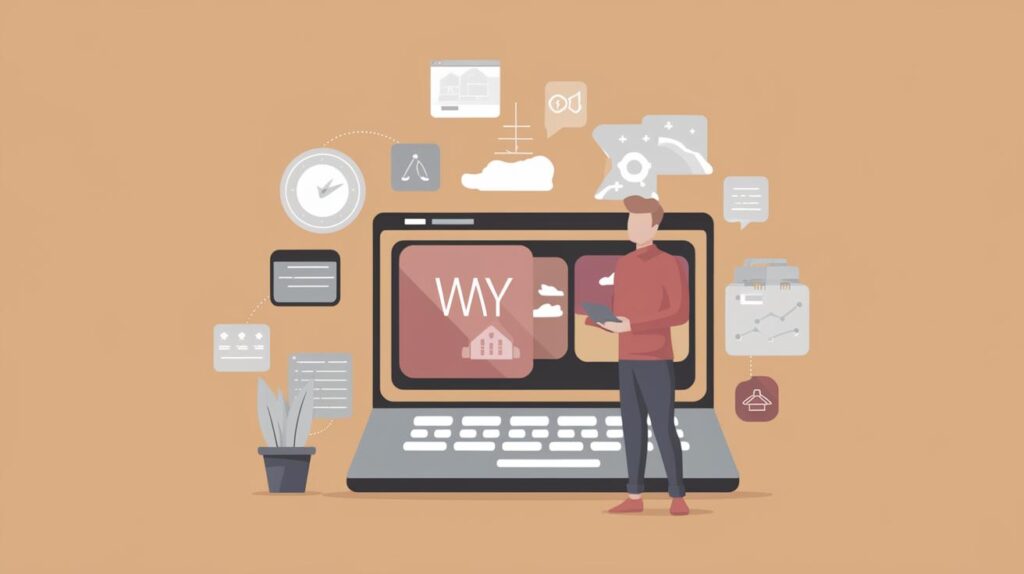How to Create a Software Program
Embarking on the journey of software development can seem daunting at first, but with structured guidance and a clear understanding of the basic concepts, it transforms into an exciting and rewarding venture. This comprehensive guide covers every facet of starting from scratch to creating a software program. It delves into choosing a programming language, lists essential programming fundamentals, sets up your development environment, and highlights various learning resources and pathways. Practical experience through personal and open-source projects is emphasized, followed by steps for building a professional portfolio and navigating the job market. Whether you’re just starting or looking to polish your skills, this article outlines a concise, yet detailed roadmap to becoming a proficient software developer.
The Role of AI in Digital Transformation Efforts
In the contemporary digital landscape, Artificial Intelligence (AI) plays an indispensable role in facilitating digital transformation across multiple industries. AI-driven processes enhance efficiency by automating mundane tasks, thereby enabling organizations to focus on innovation and development. As companies increasingly adopt AI technologies, a global reimagining of operational workflows toward more digitally-centered processes is evident. This shift prompts the demand for skilled software developers capable of creating and managing AI-centric solutions.
Digital transformation through AI since its inception has revolved around automating repetitive manual processes, predicting trends, and enabling data-driven decision-making. The strategic integration of AI resourcefully bridges the gap between simplistic digital enhancements and transformative technological shifts, thus underscoring the growing need for developers well-versed in AI frameworks and tools.
Choosing Your First Programming Language
Understanding the Basics of Software Development
The foundation of software development is centered around learning the fundamental concepts that underpin programming languages. These include understanding syntax, semantics, and the structure of a program. A developer must understand how each component works in synergy to achieve functional applications, a principle that applies regardless of which programming language is being used.
Grasping these core concepts forms the groundwork for writing efficient, effective code and is a prelude to tackling more complex software development challenges. By comprehending these basics, developers can more readily transition between languages and apply a breadth of problem-solving techniques across various scenarios.
Preparing for Your Software Development Journey
Before diving into coding, it is crucial to prepare mentally and practically for the learning journey ahead. Setting realistic goals, dedicating specific time periods for study, and identifying the motivation behind learning to program can significantly impact one’s ability to remain consistent and motivated.
Building a structured learning plan, which includes a timeline of milestones, can guide the learning process efficiently. Moreover, having clarity on what you aim to achieve, whether it’s learning for a career, developing a personal project, or enhancing problem-solving skills, will provide the necessary drive to tackle the challenges inherent in software development.
Industry Demand
The ever-evolving tech industry consistently demands skilled software developers proficient in various programming languages and technologies. Understanding market demands helps aspiring developers align their learning focus, thus enhancing both employability and career progression opportunities.
Languages like Python, Java, and JavaScript are continuously in high demand due to their versatility and prevalence in different sectors, including web development, data science, and enterprise applications. Having insight into industry trends can give developers an edge and foster adaptability in learning new tools and languages as required.
Available Learning Resources
An abundance of resources exists for aspiring software developers, catering to diverse learning preferences. Traditional textbooks, online courses, interactive coding platforms, and video tutorials are some of the various formats available for learning programming.
Furthermore, many platforms offer comprehensive learning paths, catering to beginners and advanced learners alike. Leveraging these resources effectively can ensure a deeper understanding of programming concepts and aid in the rapid acquisition of coding skills.
Areas of Interest
Identifying personal areas of interest within software development is crucial to nurturing passion and motivation. Whether it’s web development, mobile app development, game development, or data analysis, focusing on areas that spark curiosity can make the learning journey more enjoyable.
Once a niche is identified, tailored resources specific to the area can be explored, allowing for more targeted knowledge and expertise. This path also opens opportunities for specialization, making a developer more valuable within their chosen domain.
Start Small and Experiment
Starting with small, manageable projects is a critical strategy for new developers. By tackling less complex tasks, learners can build confidence as they apply newly acquired skills and knowledge in a practical setting.
Experimentation is also key. Iterating on projects, trying different coding techniques, and embracing the process of discovery through trial and error helps foster a deeper understanding of programming paradigms and enhances problem-solving capabilities.
Fundamentals of Programming
Understanding Data Types and Variables
Data types and variables form the backbone of any programming language. Understanding these basics is essential for declaring, storing, and manipulating data within a program. Common data types include integers, strings, booleans, and floats, each serving specific purposes and operations.
Variables act as placeholders for data, allowing developers to perform calculations, store user inputs, or manage the state of an application. Mastery of data types and variables facilitates logic building and is foundational to tackling more complex programming challenges.
Mastering Conditional Logic and Control Structures
Conditional logic and control structures allow developers to dictate the flow of a program, enabling responsiveness to dynamic conditions. These constructs, including if-else statements, loops, and switch cases, are pivotal in creating robust and interactive applications.
Developers who adeptly utilize control structures can implement decision-making processes in their programs, allowing for complex task executions based on varying inputs and scenarios. This capability is integral to producing efficient and functional software solutions.
Organizing Code with Functions
Code organization through functions is a fundamental practice for maintaining readability and modularity in programming. Functions enable developers to encapsulate specific tasks in reusable code blocks, simplifying program structure and enhancing maintainability.
By embracing modular programming practices, developers can streamline collaboration, improve code readability, and facilitate easier debugging and updates. A strong grasp of functions is essential for scaling projects efficiently and ensuring clean code architecture.
Setting Up Your Development Environment
Essential Tools and Software
Equipping oneself with essential tools and software is a prerequisite for an efficient development workflow. Key tools include integrated development environments (IDEs), version control systems, and debugging utilities, each addressing different aspects of the development process.
Popular IDEs such as Visual Studio Code, PyCharm, and IntelliJ provide powerful features for editing, testing, and debugging code. Version control systems like Git are indispensable for code management and collaboration. Familiarizing oneself with these tools significantly improves productivity and aids in building professional-grade applications.
Building Your First Application: A Step-by-Step Guide
Building an application from scratch is a rite of passage for aspiring developers, offering invaluable experience and insight into real-world programming challenges. Starting with a simple project, like a basic calculator or a to-do list app, serves as a practical introduction to software development.
This endeavor involves setting a project scope, designing a user interface, writing and testing code, and iterating based on feedback. Completing a tangible project fosters confidence and provides a solid foundation for tackling more complex software challenges in the future.
Learning Resources and Pathways
Free and Paid Resources
Learning to code has never been more accessible, with a plethora of free and paid resources available. From comprehensive courses on platforms like Coursera, Udacity, and Codecademy to free tutorials and documentation from programming communities, learners can choose resources that fit their budget and learning objectives.
Investment in quality learning materials, even if some are paid, is often worthwhile, offering structured curricula, expert guidance, and certification, which can significantly boost understanding and employability. It’s essential to evaluate the legitimacy and reviews of these resources to ensure effective learning outcomes.
Joining a Community
Joining a community of like-minded learners and experienced developers is invaluable for support, guidance, and collaboration. Platforms such as GitHub, Stack Overflow, and online forums offer opportunities to ask questions, share knowledge, and engage with individuals who share similar interests and challenges.
Active participation in these communities fosters a culture of learning and growth. Moreover, networking within such circles can lead to collaboration opportunities, insights into industry trends, and possible career prospects, enriching the development journey manifold.
Gaining Practical Experience
Working on Personal Projects
Practical experience is a cornerstone of effective learning in software development. Working on personal projects allows developers to apply their skills creatively, experiment with new technologies, and build a tangible portfolio of work. This hands-on approach deepens understanding and boosts confidence in tackling real-world problems.
Choosing projects that align with personal interests or address common issues ensures motivation and relevance, while simultaneously providing a platform to demonstrate competencies and innovation. Personal projects are not only learning tools but become crucial parts of a developer’s portfolio, showcasing both skill and passion.
Contributing to Open Source Projects
Contributing to open-source projects is an excellent opportunity for developers to hone their skills while collaborating with others. Open-source projects, publicly accessible repositories of code, welcome contributions from developers of all skill levels, offering a diverse platform for learning and networking.
Engaging with open source not only provides real-world experience but also fosters a sense of community and contribution. Learning from seasoned developers, gaining exposure to code review processes, and understanding collaborative coding practices enhances a developer’s expertise and readiness for professional environments.
Building a Professional Portfolio
Select Relevant Projects
Curating a professional portfolio involves selecting projects that best demonstrate your skills, expertise, and unique problem-solving abilities. Focus on including projects that align with your career objectives and are relevant to the roles you aspire to, ensuring they showcase your ability to handle challenges and deliver solutions effectively.
Showcase the Process
While highlighting finished projects is important, including a narrative of the process followed, challenges encountered, and solutions devised is even more impactful. Such insights into your workflow provide potential employers with an understanding of your problem-solving skills and adaptability.
Emphasize Results
Quantifying the impact of your projects by emphasizing results and outcomes makes your portfolio stand out. Clearly illustrating how your work produced meaningful changes, efficiencies, or improvements provides tangible evidence of your capabilities and can resonate strongly with prospective employers.
Optimize for First Impressions
Your portfolio should be well-organized and visually appealing, creating a positive first impression. Ensure that all information is neatly presented, easy to navigate, and accompanied by clear demonstrations of your skills through screenshots, code snippets, or live demos.
Navigating the Job Market
Preparing for Job Applications
As you approach the job market, preparing and tailoring your job applications is crucial. A concise, targeted resume highlighting relevant experiences, skills, and accomplishments is key to capturing the attention of potential employers.
Complementing your portfolio with a strong resume and personalized cover letters that reflect your enthusiasm and suitability for specific roles significantly enhances your employability. Identifying and articulating how you can contribute to the potential employer’s success is essential in making a memorable impact during the application process.
Interview Preparation
Preparing for job interviews is equally as important, encompassing both technical and behavioral dimensions. Practicing coding challenges, understanding software development methodologies, and exploring common interview questions helps build confidence and readiness.
Beyond technical competence, demonstrating excellent communication and problem-solving capabilities, as well as showcasing a genuine interest in the potential employer’s values and mission, can significantly sway interview outcomes in your favor. Striking a balance between technical acumen and interpersonal skills is a definitive asset in securing desired roles.
Future Prospects
In the tech-driven future, the demand for skilled software developers shows no sign of abating. Continued professional development, proactive learning, and adapting to technological advancements remain pivotal to sustaining career growth. By continuously refining skills, exploring emerging domains, and capitalizing on networking opportunities, developers can secure dynamic roles and contribute significantly to innovative digital transformations.
The journey is as much about the process as it is about the destination. Embracing learning, experimentation, and constructive challenges prepares developers not only to create impactful software but also to participate actively in shaping the technological future of industries across the globe.
| Topic | Summary |
|---|---|
| The Role of AI in Digital Transformation Efforts | A discussion on AI’s impact on digital transformation and the demand it creates for skilled developers. |
| Choosing Your First Programming Language | An overview of the basics of software development and guidance on selecting the right programming language. |
| Fundamentals of Programming | Key programming concepts such as data types, variables, and control structures. |
| Setting Up Your Development Environment | Tools needed for development and a guide to building a simple application. |
| Learning Resources and Pathways | Exploration of free and paid learning resources and the benefits of joining a developer community. |
| Gaining Practical Experience | The importance of personal projects and open-source contributions for practical learning. |
| Building a Professional Portfolio | Tips for creating a portfolio that effectively showcases skills and projects. |
| Navigating the Job Market | Strategies for job applications and preparing for interviews. |


